Cleaning the Dexp washing machine filter
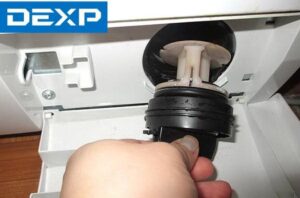 Any washing machine becomes very dirty during use, which is affected by hard tap water, soap scum, fabric particles, threads, hair, wool and other debris. All these contaminants remain on key components of the equipment, and also clog the garbage filter. If you do not clean the filter in the Dexp washing machine, as well as other parts, in a timely manner, this can lead to various problems. Any cleaning should begin with cleaning the filter, which we will discuss today.
Any washing machine becomes very dirty during use, which is affected by hard tap water, soap scum, fabric particles, threads, hair, wool and other debris. All these contaminants remain on key components of the equipment, and also clog the garbage filter. If you do not clean the filter in the Dexp washing machine, as well as other parts, in a timely manner, this can lead to various problems. Any cleaning should begin with cleaning the filter, which we will discuss today.
Lower filter element
In the “home assistants” from the Dexp company you can find two filters at once - a fill filter and a drain filter. The first is needed to purify tap water, which the equipment collects for the operating cycle. It prevents rust, sand, limescale and other debris from the water supply from entering the system.
Finding the inlet filter is very simple - it is located in the upper part of the washer body.
A drain filter is installed in the device in order to filter the already used liquid, stopping the litter. The drainage element located at the bottom of the washing machine protects the pump and sewer hose from various debris that can damage the pump and block the drain hose, making draining impossible.
It is thanks to the drain filter that most of the debris remains in a safe area of the washer - on a spiral plastic nozzle, which is installed at the outlet of the drum. You can clean the garbage filter without outside help, which will save your family budget. All you need to do is carefully repeat our guide point by point.
- First, find the drain filter - for most Dexp brand washers it is located at the bottom left of the front panel of the case.
- To remove it, you need to pick up and remove the technical hatch door, but do not rush with this procedure, because first of all you need to disconnect the device from the power supply, sewerage and water supply.
- Then move the device away from the wall to gain easy access to it.
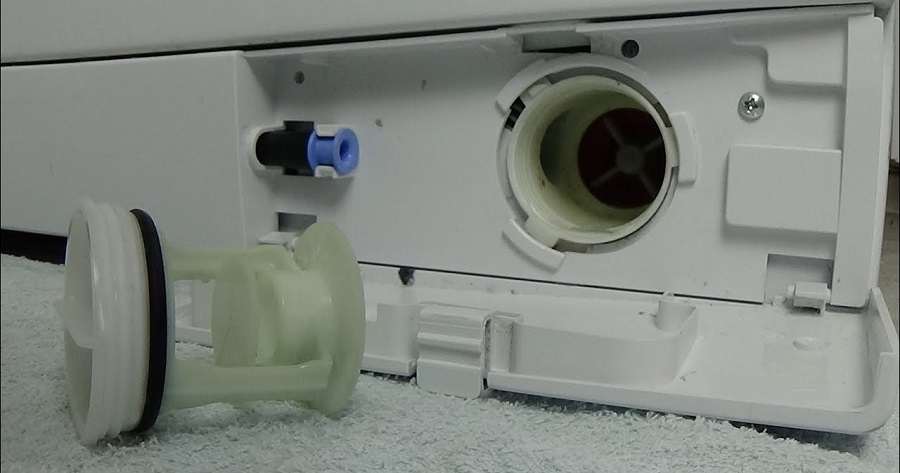
- Tilt the machine back a few centimeters and lean it against the wall for easy disassembly.
- Using a flat-head screwdriver, pry up the service hatch and press out the locking latches.
- Place a large container, such as a basin or bucket, under the garbage filter, and cover the floors with rags, just in case.
After the operating cycle, waste liquid always remains in the tank, so you should be prepared for this so as not to accidentally flood the floors and neighbors below.
- If your household appliance has an emergency drain hose, you need to activate it so that all the water goes into the prepared container.
- Unscrew the drain filter plug.
- Remove the nozzle.
The hardest part is over, now all that remains is cleaning the filter. First you need to clean out all the large debris, and then you can proceed to completely rinsing the element with a powerful stream of warm water from the tap. Do not use boiling water, as it can deform and damage the plastic parts of the filter, as well as the rubber seal.
The next step is to carefully examine the seat of the drain filter. Often it gets as clogged as the filter itself, so be sure to clean it with a soapy sponge. Next, use a flashlight to illuminate the drainage in order to locate and check the pump impeller.If it rotates freely, then nothing additional needs to be done, but if the rotation is difficult, then it is necessary to clean the blades of hair, wool, dirt and other debris.
After all the described steps, you should assemble the machine according to our instructions in the reverse order and run a test work cycle. It is enough to select a separate rinse mode to make sure that the garbage filter is working properly and does not leak. If all is well, then return the technical hatch panel to its place, and install the “home assistant” itself back in its seat.
Dirt from the filter cannot be washed off
Sometimes the user may not be able to clean the drainage element. This usually happens in a situation where it has not been cleaned for too long, or has never been cleaned at all. In this case, it cannot be washed with plain tap water, so you will have to use more serious methods.
- Cleaning with a toothbrush. Usually, caustic deposits on parts can be removed with an old toothbrush and laundry soap. Be careful when cleaning to remove all plaque.
- Soak. If even the brush does not help because dirt and plaque have become embedded in the unit, you will have to soak the filter in a solution of citric acid and soda. Dilute soda with citric acid in warm water in a ratio of approximately 20-50 grams per 1 liter of water, and then place the drain filter in the container for at least an hour. After the procedure, all you have to do is wash off any remaining dirt.
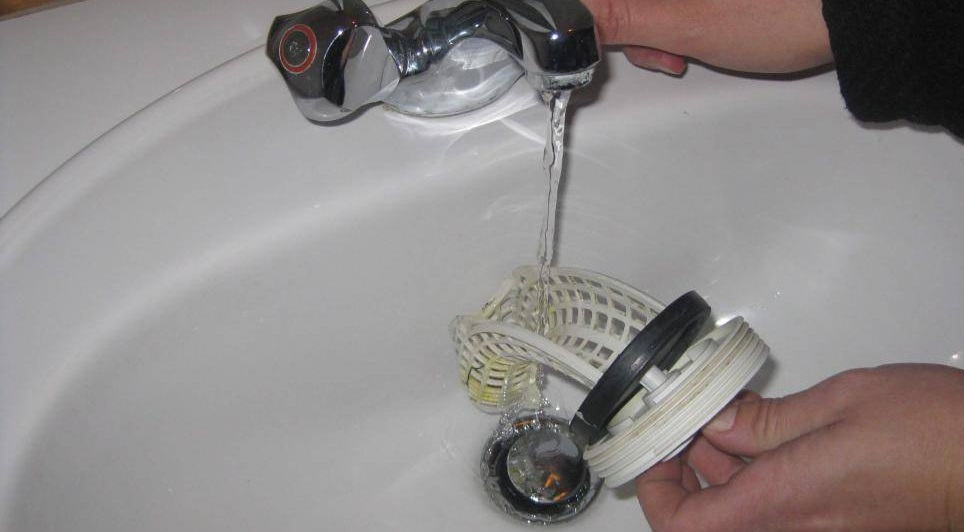
- Treatment with household chemicals. If basic household chemicals do not help, then you will have to buy a special detergent at a hardware store to combat rust and plaque.
Don’t be afraid to rub the drainage filter elements of your Dexp washing machine too hard, because they are resistant to friction and detergents. The most important thing is not to use boiling water or strong alkalis, which can damage the unit.
The part could not be unscrewed
Finally, it is worth analyzing the situation when it is not possible to start cleaning the filter due to the fact that it cannot be removed from its seat. The drainage element can be blocked by stuck debris such as a bra bone, coin, button, paper clip, hairpin, clump of hair, and so on. In addition, the unit may not be able to be removed due to the fact that it is covered with a thick layer of scale. Any of these reasons is just an additional reason to remove and clean the part as quickly as possible.
Instead of manual cleaning, you can always use the “home assistant” cleaning work cycle, for which you should buy special household chemicals to clean the system.
You will need strength and resourcefulness in situations where you need to remove a blocked part. There are three methods in total, each of which is designed for a different degree of severity of the problem. Let's look at them in order, starting with the simplest and ending with the most difficult and unpleasant.
- To begin with, you can try to remove the element using ordinary household tools, for example, pliers or pliers. It is enough to firmly fix the protruding part of the part and try to remove it by force. The most important thing is not to overdo it with force, which can cause damage to the fragile plastic element.

- The next method is to try to knock out the knot.To do this, you need to tilt the washer a few centimeters so that it rests on the wall, and then tap the entire surface near the lid with your fist. This way, you can sometimes push away debris that is blocking the drain filter.
This method can be used in a situation where the drainage element not only cannot be removed, but also dangles freely in its socket.
- Finally, the most radical way is to partially disassemble the “home assistant” and try to gain free access to the filter through the drain pump. In this case, you will have to lay the washing machine on its side, remove the bottom, find the pump inside the housing and remove it. After this, you need to clean the drainage and drain filter, and also treat the element with WD-40 lubricant, which will help remove stubborn scale.
As you can see, you can deal with a blocked garbage filter without calling a service center specialist. But it is much better not to allow this to happen at all, but simply clean the filter at least once a quarter along with cleaning the drain. At the same time, if you have pets at home, or you often wash wool clothes, then it is better to clean once a month.
Interesting:
Reader comments
- Share your opinion - leave a comment
Categories
Washing machine repair


For buyers

For users

Dishwasher


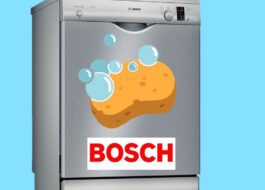
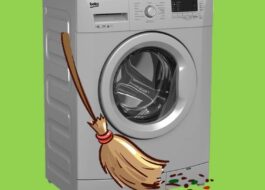
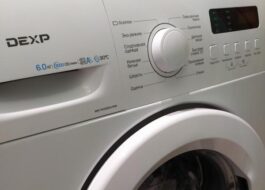
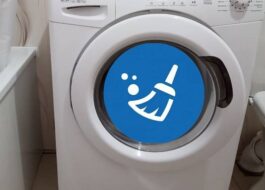











Add a comment